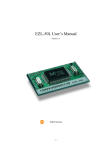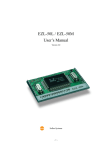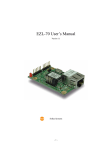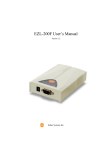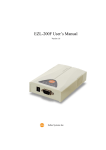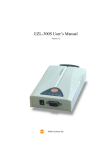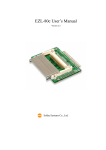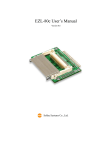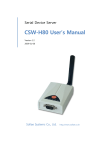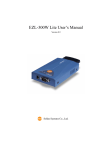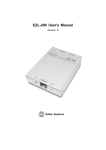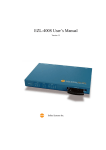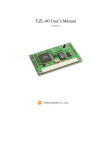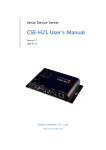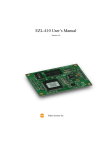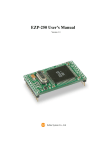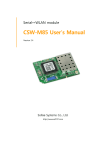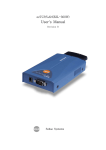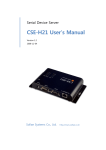Download EZL-50L User`s Manual
Transcript
EZL-50L User’s Manual Version 1.0 Sollae Systems -1- - Table of Contents 1. OVERVIEW..................................................................................................................... - 5 - 1.1. OVERVIEW ......................................................................................................................- 5 - 1.2. COMPONENTS..................................................................................................................- 6 - 1.3. SPECIFICATIONS ..............................................................................................................- 6 - 1.4. INTERFACE ......................................................................................................................- 6 - 1.4.1. Power ............................................................................................................................ - 7 - 1.4.2. Ethernet Interface.......................................................................................................... - 8 - 1.4.3. I/O Interface .................................................................................................................. - 8 - 1.4.4. Ethernet Address (MAC address) .................................................................................. - 9 - 1.4.5. Hardware Flow control (RTS/CTS)............................................................................... - 9 - 1.5. THE EVALUATION BOARD SET ........................................................................................- 9 - 1.5.1. Components................................................................................................................... - 9 - 1.5.2. The Explanation of EVB.............................................................................................. - 10 - 2. INSTALLATION AND TEST RUN ............................................................................. - 11 - 2.1. INSTALLATION METHOD ................................................................................................- 11 - 2.1.1. Checking the Communication Environment................................................................ - 11 - 2.1.2. Connecting to the Network.......................................................................................... - 11 - 2.1.3. Configuring the Environmental Variables ................................................................... - 12 - 2.2. TEST RUN......................................................................................................................- 12 - 2.2.1. Changing PC IP Address............................................................................................. - 12 - 2.2.2. Installation EZL-50L................................................................................................... - 12 - 2.2.3. Configuring EZL-50L.................................................................................................. - 12 - 2.2.4. Connecting to the PC Serial Port................................................................................ - 13 - 2.2.5. Communication Test .................................................................................................... - 13 - 3. CONFIGURING IP ADDRESS AND ENVIRONMENTAL VARIABLES .............. - 14 - 3.1. IP ADDRESS AND ENVIRONMENTAL VARIABLES ............................................................- 14 - 3.2. CONFIGURATION BY EZCONFIG .....................................................................................- 18 - 3.2.1. ezConfig Menu ............................................................................................................ - 18 - 3.2.2. Example configuration of ezConfig (LOCAL)............................................................. - 20 - 3.2.3. Example configuration of ezConfig (REMOTE).......................................................... - 22 - 3.3. AT COMMAND...............................................................................................................- 23 - 3.4. SETTING IP ADDRESS-RELATED ITEMS BY DHCP.........................................................- 23 - 3.5. SETTING IP ADDRESS-RELATED ITEMS BY PPPOE ........................................................- 23 - -2- 4. OPERATION MODE.................................................................................................... - 24 - 4.1. OPERATION MODE OVERVIEW ......................................................................................- 24 - 4.1.1. Overview ..................................................................................................................... - 24 - 4.2. HOW TO INITIATE EACH OPERATION MODE ..................................................................- 24 - 4.2.1. How to Initiate Normal Mode ..................................................................................... - 24 - 4.2.2. Entering ISP Mode ...................................................................................................... - 24 - 4.2.3. Comparison of Operation Modes ................................................................................ - 24 - 4.3. NORMAL COMMUNICATION MODE ................................................................................- 24 - 4.4. ISP MODE .....................................................................................................................- 25 - 5. NORMAL COMMUNICATION MODE .................................................................... - 27 - 5.1. T2S(TCP TO SERIAL) ...................................................................................................- 27 - 5.2. ATC (AT COMMAND)....................................................................................................- 29 - 5.3. COD (CONNECT ON DEMAND) .....................................................................................- 31 - 5.4. U2S...............................................................................................................................- 33 - 6. ATC MODE ................................................................................................................... - 35 - 6.1. OVERVIEW ....................................................................................................................- 35 - 6.1.1. AT command format .................................................................................................... - 35 - 6.2. BASIC AT COMMAND SET (EXAMPLE: ATA, ATD ETC.) ................................................- 35 - 6.3. EXTENDED AT COMMANDS (EXAMPLE: AT+PLIP ETC.) ...............................................- 36 - 6.4. ONLINE STATE AND ONLINE COMMAND STATE .............................................................- 36 - 6.4.1. Changing Online State to Online Command State ...................................................... - 36 - 6.4.2. Changing Online Command State to Online State ...................................................... - 37 - 6.5. EXAMPLE OF CONFIGURATION WITH AT COMMAND......................................................- 37 - 6.6. EXAMPLE OF TCP CONNECTION ...................................................................................- 37 - 6.6.1. Example of Active Connection .................................................................................... - 37 - 6.6.2. Example of passive Connection................................................................................... - 38 - 6.7. EXAMPLE OF TCP DISCONNECTION ..............................................................................- 38 - 6.7.1. Example of active disconnection ................................................................................. - 38 - 6.7.2. Example of passive disconnection............................................................................... - 38 - 7. TECHNICAL SUPPORT, WARRANTY, AND NOTES ON OPERATION............. - 39 - 7.1. TECHNICAL SUPPORT ....................................................................................................- 39 - 7.2. WARRANTY ..................................................................................................................- 39 - 7.2.1. Refund ......................................................................................................................... - 39 - 7.2.2. Free Repair Services ................................................................................................... - 39 - -3- 7.2.3. Charged Repair Services............................................................................................. - 39 - 7.2.4. Notes on Operation ..................................................................................................... - 39 - -4- 1. Overview 1.1. Overview Along with the development of the Internet, the demand for data communication functions has increased recently. Data communication over the Internet requires using TCP/IP, the Internet communication protocol. That is to say, in order to connect a system to the Internet, TCP/IP protocol must be implemented. It is possible to implement TCP/IP by directly implementing the protocol, porting public TCP/IP, or using Operating System (OS). However, all these methods impose burdens on the developer in time, cost, and technology. ezTCP series, a Serial ↔ TCP/IP protocol converter product group of Sollae Systems, enables you to use TCP/IP communication (the Internet communication) function simply by “connecting the cable to a serial port”. ezTCP sends data from the serial port to the Internet network after TCP/IP processing, and vice versa. EZL-50L in ezTCP product group is a product that provides TCP/IP communication through Ethernet. In other words, like other ezTCP products, EZL-50L sends data from the serial port to the LAN after TCP/IP processing and vice versa. It provides DHCP and PPPoE functions as well as TCP/UDP/IP, so that it can be applied to the cable network and the xDSL network. EZL-50 is a modular and embedded type that is embedded in user’s systems. -5- 1.2. Components z EZL-50L Body z RJ-45 with pulse-transformer (option) z EZL-50 Evaluation set (option) 1.3. Specifications Power 5V (±10%) Current 72mA typical Dimension 50mm x 32mm x 11mm Weight about10g Interface Serial 2mm pitch 1x12 connector Network 2mm pitch 1x12 connector Serial Port UART (1200bps ~ 115200bps) Network 10Base-T Protocols TCP, UDP, IP, ICMP, ARP, DHCP, PPPoE Communication Mode Utilities ) Input Voltage T2S TCP Server Mode COD TCP Client Mode TCP Server/Client Mode ATC (AT command emulation) U2S UDP ezConfig Configuration utility via LAN ezterm Socket test utility hotflash Firmware download utility via TFTP You can download free utilities and firmware from http://www.eztcp.com . 1.4. Interface -6- PIN NAME Function VCC Power Input (DC 5V) ● GND Ground ● TP_IN+ TP_INTP_OUT- TP_OUT+ I/O 10Base-T Differential Input + 10Base-T Differential Input 10Base-T Differential Output 10Base-T Differential Output + mandatory IN ● IN ● OUT ● OUT ● Recommended connection option RX_LED+ 10Base-T RX LED OUT ● ● TX_LED+ 10Base-T TX LED OUT ● ● LINK_LED- 10Base-T Link LED OUT ● ● STATUS EZL-50 Status OUT ● ● RST+ Reset(Active High) IN ● Connect Notifier P0 (During TCP OUT ● ● Connection:Low) TXDE, for interface with RS485 P1 When Transmitting to the OUT ● UART: HIGH In ISP- System Programming(Active Low) IN TxD UART TxD OUT RTS UART RTS OUT RxD UART RxD IN CTS UART CTS IN ) ● ● ● ● ● ● It is OK that [Recommended Connection] is not connected, but we strongly recommend to connect those. 1.4.1. Power DC 5V is used for EZL-50L -7- 1.4.2. Ethernet Interface EZL-50L has a 10Base-T Ethernet interface. It is necessary additional circuit for an Ethernet interface. For the information of the RJ-45 with pulse-transformer (P02-10217C9), visit our website (http://www.eztcp.com) [EZL-50L Ethernet interface – TOP view] 1.4.3. I/O Interface Name Status Description IP is allocated but TCP connection is not established Repetition of HIGH/LOW for 500ms -8- IP is not allocated – Repetition of [after repetition 4 times for 150ms, HIGH during 850ms] During TCP connection – LOW ISP Mode – Repetition HIGH/LOW for 50ms LINK_LED- When connected to LAN - LOW RX_LED+ There are data on LAN - HIGH TX_LED+ Packets are transmitted to LAN - HIGH During TCP connected– LOW P0 During TCP disconnected - HIGH During data transmitted to serial – HIGH P1 For interfacing RS485 chip(TXDE) 1.4.4. Ethernet Address (MAC address) Ethernet devices have unique 6 bytes-hardware address. The hardware address of EZL-50L is set in the factory. The hardware address cannot be modified. The address is printed in top of PCB of EZL-50L. 1.4.5. Hardware Flow control (RTS/CTS) If RTS/CTS is set, the EZL-50L operates as follows: RTS There’s are available receiving buffer of EZL-50L – LOW Output Their is no available receiving buffer of EZL-50L – HIGH This signal is connected to counter side device’s RTS(output port) CTS Input LOW – EZL-50L sends data to serial port HIGH – EZL-50L doesn’t send data and wait until CTS is LOW 1.5. The Evaluation Board Set The evaluation Board (EVB) is for testing with PC when user develops with EZL-50L. User can test with PC if EZL-50L is inserted in EVB, power on with 5V adapter, connect RS232 cable to PC, and connect Ethernet cable to hub. 1.5.1. Components z Evaluation Board z RS-232 cable -9- z 5V SMPS adapter 1.5.2. The Explanation of EVB - 10 - 2. Installation and Test Run 2.1. Installation Method You can install EZL-50L in the following steps: Title Item 1. Checking the communication environment Check items 2. Connecting to the network Check method Sub-item Configuration method 3. Configuring the environmental variables Configuration items Description IP address environment 3.1. Serial port settings 3.1. Application program to be used 4. Check if LINK LED is ON. 1.4.4. Set by ezConfig, a utility program for configuration through the network. 3.2. Set by AT commands in ATC mode 6. IP address related items 3.1. Serial port related items 3.1. Communication mode (Decided depending on application program) 4. 4. Application to the field 2.1.1. Checking the Communication Environment Before installing EZL-50L, check the network environment where EZL-50L is to be installed, including the followings matters: z IP address environment (local IP, subnet mask, gateway, etc.) z Serial port items of the equipment to which EZL-50L is going to be connected (baud rate, data bit, parity, stop bit) z Application program protocol to be used (TCP/UDP, server/client, etc.) z For application program protocol to be used, see “5. Normal Communication Mode”. 2.1.2. Connecting to the Network Connect power to EZL-50L, and connect EZL-50L directly to the Ethernet port of the - 11 - PC where test is to be performed with a cross-over Ethernet cable. 2.1.3. Configuring the Environmental Variables When network connection is completed, configure the environmental variables such as IP address related items, serial port related items, and communication mode related items through the LAN using “ezConfig,” the environmental variable configuration program. For environmental variable configuration, see “3.Configuring IP Address and Environmental Variables.” 2.2. Test Run You can perform test run according to the following orders. The test run described here is based on the assumption that the user uses EVB with EZL-50L and the IP address of the PC is set to 10.1.0.2. 2.2.1. Changing PC IP Address You can change the IP address of your PC as follows: IP Address 10.1.0.2 Subnet Mask 255.0.0.0 Gateway IP Address 0.0.0.0 2.2.2. Installation EZL-50L Connect the supplied RS232 cable between your PC and EVB, the LAN cable to the hub to which the PC is connected or directly to the PC with a cross-over cable, and the supplied EVB power adapter to EVB for power supply. If the LAN cable has been correctly connected when power is supplied, LINK LED turns on. 2.2.3. Configuring EZL-50L Configure EZL-50L setting using ezConfig, the ezTCP configuration program, as follows. Run ezConfig, and click [Search ezTCP] button in the ezConfig window. And, ezConfig program will search all ezTCPs on the local network. When ezTCP is searched, MAC address of the ezTCP is displayed on the [Search List] window (The MAC address is indicated at the bottom of the product case). - 12 - Select the corresponding MAC address, and set the same as shown in the following figure and click [Write] button to save the settings. 2.2.4. Connecting to the PC Serial Port Connect the serial port of your PC and that of EVB, using the supplied serial communication cable. Then, run serial communication program such as Hyper Terminal and Teraterm. When the program is run, select the same serial port values as those set to EZL-50L [19200bps, data bit: 8 bits, stop bit: 1 bit, no parity], which will finish the preparation for serial communication. 2.2.5. Communication Test When the preparation for serial communication is finished, enter the following in the DOS window on your PC, to connect to TCP through Telnet program. "Telnet 10.1.0.1 1470" When TCP connection succeeds, STS LED of EVB turns ON. When the STS LED turns ON, enter “123” on the Telnet window, and "123" will appear on the hyper terminal. Enter “ABC” on the hyper terminal, and “ABC” will appear on the Telnet window. Otherwise, communication test fails. - 13 - 3. Configuring IP Address and Environmental Variables 3.1. IP Address and Environmental Variables For TCP/IP communication, you must set IP address related items. In addition, you have to set serial port related items (baud-rate, data bit length, parity bit, flow control, etc) to EZL-50L. You can set the IP address and the serial port related items by using ezConfig, the supplied configuration utility which allows you to configure your EZL-50L over the network, or by using AT commands in ATC mode. Item Description Local IP Address IP address of EZL-50L Subnet Mask Subnet mask Gateway IP Address IP address of gateway Port number for waiting to be Local Port connected in Server mode Port number for waiting UDP data IP Address-related Items IP address to connect in Client mode Peer IP Address IP address to send data in UDP mode Port number to connect in Client mode Peer Port Port number to send data in UDP mode Serial Port Communication Mode Connect/Disconnect Event Permitted IP Address Permitted IP address in server mode. Baudrate Serial Port Speed(bps) Data bits Data bit length Parity Parity Stop bit Stop bit Flow Control Flow control ezTCP Mode Communication Mode Minimum number of bytes attempting Conn. Byte to connect/transmit - 14 - Timeout Limit time to keep connection ezConfig Enable ezConfig function. Remote configuration function with Remote Search Configuration Method Used UDP unicast Password ezConfig password. ARP Enable IP setting by ARP. Select to receive EZL-50L IP address DHCP Dynamic IP Address as DHCP. Select to receive EZL-50L IP address PPPoE PPPoE as PPPoE. ID & ID and password to be used for Password z PPPoE Local IP Address IP address of EZL-50L. If you set DHCP or PPPoE is set, an IP address is automatically allocated. So, you cannot set the local IP address. z Subnet Mask Sets subnet mask of the network where EZL-50L is installed z Gateway IP Address Sets the gateway IP address of the network where EZL-50L is installed. z Permitted IP Address It is a permitted IP address of foreign host when EZL-50L operates as a server. The only host that is written in this item can connect to EZL-50L. If Permitted IP Address is 0.0.0.0, all hosts can connect to the EZL-50L. z Local Port Port number, which is used as TCP port number waiting to be connected when EZL-50L operates as TCP server or as the port number waiting for UDP data when it operates in U2S communication mode. z Peer Port Local port number of the server to connect when EZL-50L operates as TCP client or to - 15 - transmit UDP data when it operates as U2S z Baudrate Selects a serial port speed (1200 bps ∼ 115200bps). z Data bits Selects a data bit length of the serial port (7 bits or 8 bits) z Parity Select a parity bit of the serial port (None, Even, Odd). z Stop bit Selects a stop bit length of the serial port (1 bit). z Flow Control Selects flow control for the serial port (None, RTS/CTS, Xon/Xoff). z ezTCP Mode Selects the communication mode of EZL-50L (T2S, ATC, COD, U2S). z Conn. Byte Decides a point of time to start connection when EZL-50L operates as COD. EZL-50L starts to connect to the host (Peer IP Address and Peer Port) of the designated host upon receiving as many data as specified by [Conn. Byte] from the serial port. z Block(Byte) Decides the size of UDP packet to be sent at a time when EZL-50L operates as U2S. z Timeout When EZL-50L operates as TCP such as T2S, COD and ATC, connection is closed if data communication is not continued as long as the time set to this item unless this item is set to 0 (unit: second) z Interval When EZL-50L operates as UDP like U2S, it transmits data in blocks by gathering data for the time set to this item (unit: 10ms) - 16 - z ezConfig You can use ezConfig utility only this item is enabled. (If this item is not enabled, you cannot set EZL-50L using ezConfig. Therefore, it is recommended to enable this all the times.) To enable ezConfig, set this item in ISP mode. z Remote Search If this item is set, EZL-50L in other network can be configured by ezConfig. Remote Search function is performed in the [REMOTE] tab. z Password Sets a password for configuring with ezConfig. If user forgot the password, the user can delete the password in ISP mode. z ARP When this item is selected, EZL-50L uses the destination IP address of the first packet coming to its MAC address as its own IP address temporarily. This item should be set in DHCP environment if required. z DHCP Set to receive an IP address as DHCP. z PPPoE Set to receive an IP address as PPPoE. z PPPoE ID & Password Sets ID and password used for PPPoE. EZL-50L uses maximum 32 byte for saving an ID and 8 bytes for a password. z Comment Stores maximum 32 byte user comment on the product. This item helps the user distinguish each EZL-50L more easily. - 17 - 3.2. Configuration by ezConfig 3.2.1. ezConfig Menu The basic environmental variables (IP address related items, serial port items, and etc.) can be set by ezConfig which is an integrated management tool for Windows. ezConfig is operated in Microsoft Windows(Windows 98, 98 SE, 2000 Pro, ME, XP Pro/Home). Following is the screen shot of ezConfig which is just launched √ ezConfig can set not only EZL-50L’s environmental variables but also other ezTCP series. ezConfig configures ezTCP by Ethernet, there are two way to configure. The first way is UDP broadcast. When using UDP broadcast, user can search all ezTCPs in the same network without knowledge of IP address. But beware that it can be used in the ‘same network’. This method performed in the [LOCAL] tab of ezconfig version above 4.0. The second way is UDP unicast that communicates by IP address. As it configured with IP address, EZL-50L is configured any place if they are connected with network. This method performed in the [REMOET] tab of ezconfig version above 4.0. (ezConfig below version 4.0 supports only UDP broadcast) LOCAL REMOTE - 18 - communication UDP broadcast UDP unicast (port: 50005) search With MAC address with IP address location In the same network with EZL-50L Can be used in a different network The functions of ezConfig’s buttons are followed: This button is used to search for all of the network-attached ezTCPs. The search results will be displayed on the [Search List] box and you can select an item using a mouse or cursor as required. The value displayed on the box indicates the MAC ADDRESS of each ezTCP. The selected setup value of ezTCP will be displayed on the right side. [LOCAL]tab:. You can see only the ezTCP configuration values if you press this button after entering the 6-digit hexadecimal number printed on the ezTCP main body in the MAC ADDRESS box. It is useful when there are too many ezTCPs attached to the network to search for one from the LIST box. [REMOTE] tab: Reading environmental variables with the IP address. This button is used to save the changed value in ezTCP after modifying the configuration. Make sure not to press this button during operating ezTCP since ezTCP will automatically be reset right after its environment setup value is saved. Otherwise, it may cause malfunction. Terminating ezConfig. ezTCP provides User Authentication function to prevent an unwanted person from modifying the configuration. The authentication process is performed through the password string verification. When entering or changing the password strings, you can use this button. Changing the ezTCP configuration details if a password - 19 - has been entered requires the proper password to be entered in the PASSWORD field. √ If you forget the password, erase or reenter in ISP Mode. This button is used to read a dynamic status during operating ezTCP. Pressing this button will display a new window, where the time-elapsed after the power is on, the current IP address, and the data throughput of the serial port are indicated. Double-clicking each item on the [Search List] will carry out the same function. 3.2.2. Example configuration of ezConfig (LOCAL) ezConfig can be used to change the IP address related items, the serial port setup value, the serial port operation mode. This section describes these functions briefly. For more information, see the following sections. The following example shows how to read and change ezTCP's basic functions. Try changing ezTCP setup value according to the following sequence z When the ezTCP power is turned on and the LAN cable is connected correctly, pressing [Search] or [Read] button will display the following window: z If a network-attached ezTCP is detected, the following message will be displayed. If a message pops up indicating that there is no response from ezTCP, check that the power is turned on and the cable is connected correctly, then try pressing [Search] or [Read] button. √ It is impossible to use ezConfig, if EZCFG check box is disabled. This function can be - 20 - re-enabled in ISP mode. z If more than one ezTCP are detected, ezTCP's MAC ADDRESS will be displayed in the [Search List] box on ezConfig. Check if the MAC ADDRESS displayed in the [Search List] window corresponds to that printed on ezTCP main body. The following screen shows this process: Following is the screenshot when ezTCPs were found. z Set [ezTCP Mode], [Local IP Address], [Local Port], and serial port related items. After setting press [Write] button. If there is any error during writing process, check the LAN between PC and EZL-50L. z Check if the set IP address is correct with ping command in DOS prompt. Following is the message if the IP address is OK. If "Request timed out" message is shown, check IP address. . C:\>ping a.b.c.d - 21 - Pinging a.b.c.d with 32 bytes of data: Reply from a.b.c.d: bytes=32 time=1ms TTL=64 Reply from a.b.c.d: bytes=32 time=1ms TTL=64 Reply from a.b.c.d: bytes=32 time=1ms TTL=64 Reply from a.b.c.d: bytes=32 time=1ms TTL=64 <When IP address is a.b.c.d.> √ IP address, subnet mask, and gateway IP address of both PC and EZL-50L should be correct to succeed in ping test. 3.2.3. Example configuration of ezConfig (REMOTE) z Input the IP address of EZL-50L in IP address field in the [REMOTE] tab, and press [Read] button. Then following window will be appeared. z If the EZL-50L is found, the following will be shown. z Configure variables and press [Write] button. - 22 - 3.3. AT command In ATC mode, the user can set environment variables through the serial port using AT command. ) 3.4. For more information, See “6. ATC Mode”. Setting IP Address-related Items by DHCP Under environment with a network operating a DHCP server, DHCP protocol allows the user to automatically set the IP address, subnet mask, gateway, and name server of ezTCP. Using DHCP automatic setup function requires the user to check [DHCP] item on ezConfig. Note that the user may have to check [ARP] item according to the type of DHCP servers. 3.5. Setting IP Address-related Items by PPPoE PPPoE is used in most ADSL and VDSL. To use PPPoE function, PPPoE function should be enabled and PPPoE ID and PPPoE password should be configured. The local IP address of EZL-50L is assigned automatically in PPPoE environment. √ Some ADSL or VDSL modem use DHCP. Please contact your ISP (Internet Service Provider). - 23 - 4. Operation Mode 4.1. Operation Mode Overview 4.1.1. Overview EZL-50L can operate in one of two modes (normal and ISP modes). Normal mode is ordinary data communication mode; and ISP mode is used to download EZL-50L firmware through the ethernet(TFTP). 4.2. How to Initiate Each Operation Mode 4.2.1. How to Initiate Normal Mode Normal mode is a mode in which EZL-50L performs its original functions. If ISP- is HIGH when EZL-50L boots up, EZL-50L operates in normal mode. For more information, see “5. Normal Communication Mode.” 4.2.2. Entering ISP Mode Supply power or reset to EZL-50L with ISP- pin LOW. If EZL-50L operates as ISP Mode, Status repeats HIGH/LOW state rapidly. 4.2.3. Comparison of Operation Modes The following table is the comparison of the above described operation modes. Mode How to Initiate normal Supply power or ISP reset with ISPLOW 4.3. Description Normal data communication mode T2S, ATC, COD, U2S Download firmware through the ethernet Serial Port User setting 19200bps,N,8,1 Normal Communication Mode Normal communication mode is suitable for the purpose of using EZL-50L. Normal communication mode can be classified into four modes – T2S, ATC, COD, and U2S – each of which is described in the following table. - 24 - Communication Mode Protocol T2S TCP ATC TCP COD TCP U2S UDP Connection Passive Connection Active/Passive Connection Active Connection No Connection Need for User Configuration of Equipment Environmental Software Variables through Modification Serial Port Not needed Impossible 1:1 Needed Possible 1:1 Not needed Impossible 1:1 Not needed Impossible N:M Topology TCP protocol requires connection process. The connection is always established as 1:1 connection. At this time, the host waiting for connection (passive connection) is called a server and the one attempting to connect (active connection) is called a client. On the other hand, UDP communicates by block unit without connection process. As UDP does not require connection, numbers of hosts can communicate at the same time. ) 4.4. For more information on communication modes, refer to the next chapter. ISP Mode In ISP mode, you can download the latest firmware (EZL-50L operation software) provided by our company. The following section describes how to download firmware in ISP mode. z Supply power or reset to EZL-50L with ISP- pin LOW. If EZL-50L operates as ISP Mode, Status repeats HIGH/LOW state rapidly. z Run hotflash that is supplied by Sollae Systems. - 25 - z Select a firmware in the [FILE] menu, and input the IP address of EZL-50L and press [SEND] button. Then the firmware will be transferred by Ethernet. z After completion, a message that informs the firmware was downloaded successfully. And EZL-50L reboots automatically and run in Normal Mode. In Normal Mode, Status is blink every 1 second. z After completion download, reset with ISP HIGH. - 26 - 5. Normal Communication Mode 5.1. T2S(TCP To Serial) When a host connects to predefined local port, the EZL-50L accepts a TCP connection. When the EZL-50L accepts TCP connection, then the TCP connection is established. After connection is established, TCP/IP processing is performed on the data coming to the serial port, which is then transmitted to the remote host. And the TCP/IP data coming from the remote host is TCP/IP-processed and transmitted to the serial port to establish data communication. (Data coming to the serial port before TCP connection is established will be ignored.) To limit the peer host, user should set [Peer IP Address]. The only pre-defined host can be accessible. If [Permitted IP Address] is 0.0.0.0, any host can connect to EZL-50L. - 27 - Set the following for T2S mode: Item Description Local IP Address IP address of EZL-50L Subnet Mask Subnet mask Gateway IP Address Relate Address Items Local Port Permitted IP IP address of gateway Port number for waiting to be connected in Server mode IP Permitted host to connect Address (if set to 0.0.0.0, any host can connect) Baudrate Serial port speed (bps) Data bits Data bit length Parity Parity Stop bit Stop bit Flow Control Flow control ezTCP Mode Communication Mode (T2S(0)) Disconnection Timeout Limit time to keep connection Configuration ezConfig Enable ezConfig function. Method Password ezConfig password. Serial Port Communication Mode DHCP Dynamic IP PPPoE Select to receive EZL-50L IP address as DHCP. Select to receive EZL-50L IP address as PPPoE. - 28 - 5.2. ATC (AT Command) In ATC mode, the user can control the EZL-50L in a similar way to controlling the modem using AT command. In ATC mode, only a TCP connection is possible and both the server and the client can be configured. In ATC mode, the AT command allows the user to set environment variables including the IP address and control disconnection. - 29 - TCP connection and Set the following for ATC mode. Item Description Local IP Address IP address of EZL-50L Subnet Mask Subnet mask Gateway IP Address IP Address IP address of gateway Local Port Port number for waiting to be connected in Server mode Peer IP Address Peer IP address to connect Peer Port Baudrate Peer port number to connect Serial port speed (bps) Data bits Data bit length Parity Parity Stop bit Stop bit Flow Control Flow control ezTCP Mode Communication mode(ATC(1)) Disconnection Timeout Limit time to keep connection Configuration ezConfig Enable ezConfig function. Method Password ezConfig password. Relate Items Serial Port Communication Mode DHCP Dynamic IP PPPoE ) Select to receive EZL-50L IP address as DHCP. Select to receive EZL-50L IP address as PPPoE. See “6. ATC Mode.” - 30 - 5.3. COD (Connect On Demand) In COD mode, the EZL-50L functions as a client. When data of the pre-specified size [CONN BYTE] comes to the serial port, the EZL50L attempts a TCP connection to the TCP port [PEER PORT] of the preset host IP [PEER IP ADDRESS]. If the remote host accepts the TCP connection, TCP connection will be established. Data coming to the serial port after connection establishment is TCP/IP-processed and transmitted to the remote host. And, data coming from the remote host is TCP/IP-processed and transmitted to the serial port for data communication. - 31 - Set the following for COD mode. Item Description Local IP Address Subnet Mask IP Address Related Item Gateway IP Address Peer IP Address Serial Port Mode Connection/ Subnet mask IP address of gateway Peer IP address to connect Peer Port Peer port number to connect Baudrate Serial port speed (bps) Data bits Data bit length Parity Stop bit Communication IP address of EZL-50L Parity Stop bit Flow Control Flow control ezTCP Mode Communication mode(COD(2)) Conn. Byte Bytes for starting to connect Disconnection Timeout Limit time to keep connection Configuration ezConfig Enable ezConfig function. Method Password Dynamic DHCP ezConfig password Select to receive EZL-50L IP address as DHCP. Select to receive EZL-50L IP address as PPPoE. IP Address PPPoE - 32 - 5.4. U2S U2S mode allows for UDP communication. In UDP mode, data are transmitted in blocks, which requires dividing data coming to the serial port into blocks before transmitting data. A procedure for dividing data into blocks is as follows: If data of pre-specified bytes [Conn. Byte] comes to the serial port of the ezTCP or if a specified period of time [TIMEOUT] elapses after first data reception, all data received for the same period is recognized as one block which is then transmitted to the UDP. The [TIMEOUT] unit is 10ms. If [TIMEOUT] is set to 2, the time period is between 20ms and 30ms. Since UDP communication does not require a connection procedure, the user can establish N-to-M communication via multicast and broadcast. . - 33 - Set the following for U2S mode. Item Description Local IP Address IP address of EZL-50L Subnet Mask IP address Related Item Gateway IP Address Local Port Peer IP Address Serial Port Mode Port number for UDP data receving Peer IP address to transmit Peer port number to transmit Baudrate Serial port speed (bps) Data bits Data bit length Parity Parity Stop bit Flow Control Flow control ezTCP Mode Communication mode(U2S(3)) Block Packets IP address of gateway Peer Port Stop bit Communication Subnet mask Interval UDP block size to transmit (unit: byte) Data gathering time from serial port to transmit as UDP (unit:10ms) Configuration ezConfig Enable ezConfig function. Method Password ezConfig password. - 34 - 6. ATC Mode 6.1. Overview EZL-50L can be controlled by AT commands in ATC mode. For example, the peer host IP address can be set by AT+PRIP command and connect to the host by ATD command. Therefore, EZL-50L communicates several hosts alternatively. And also, it provides passive connection function by ATA command. 6.1.1. AT command format AT commands start with AT, and end <CR>. AT command format is followed. AT Command <CR>(0x0d) The response code to AT command is followed. Response message <CR>(0x0d) <LF>(0x0a) Response Message 6.2. When ATV1 (initial setting) When ATV0 Description OK 0 command OK CONNECT 1 TCP connected NO CARRIER 3 TCP disconnected ERROR 4 Command error Set value Set value When query set value (example: AT+PRIIP?) Basic AT Command Set (Example: ATA, ATD etc.) Command Function Description A passive connection Listen connection (host → EZL-50L connection) D active connection Connecting to host from EZL-50L E echo H off-hook I Inquery O Online To online mode V enable result code Result code (numeric-V0, alphabetic-V1) Echo (E0 - no echo, E1-echo) disconnection Output EZL-200 related-information - 35 - Z 6.3. 6.4. reset Reset Extended AT Commands (Example: AT+PLIP etc.) Command Function Description +PLIP local IP address +PSM subnet mask +PGIP default router +PLP listening TCP port +PTO timeout +PRIP Remote machine IP address +PRP Remote machine TCP port +PWP Write configuration Saving and Reset +PRC ezConfig enable/disable ON: 1, OFF: 0 +PARP ARP setting function enable/disable ON: 1, OFF: 0 +PDC DHCP enable/disable ON: 1, OFF: 0 Online State and Online Command State It is online command mode during disconnected. AT commands can be used in online command mode. After TCP connection, AT commands cannot be used. To use AT commands during the connection, change state to online command state. Online Command State Online State During TCP disconnected, AT commands can be used To use AT commands during the connection, required escape sequence During TCP connected, all serial data to EZL-50L convert TCP and send to ethernet 6.4.1. Changing Online State to Online Command State To change online state to online command state during the connection, +++ string should be transmitted to EZL-50L as following time interval. When transmitting +++ string to EZL-50L, +++ string will be sent to peer host. The time from final data the first ‘+’ data of No data over 500ms(guard time) - 36 - ‘+++’ string time intervals between ‘+’s 0~500ms Time interval after receiving last ‘+’ No data over 500ms (guard time) 6.4.2. Changing Online Command State to Online State If EZL-50L’s state is in online command state during TCP connection, EZL-50L’s state can be changed into online state by an ATO command. 6.5. Example of Configuration with AT Command Serial Port AT+PLIP=192.168.1.200<CR> ◀ ◀ ◀ ◀ 6.6. ▶ Setting SUBNET MASK Command OK ▶ Setting LOCAL PORT Command OK ▶ <CR><LF>OK<CR><LF> AT+PWP<CR> Setting GATEWAY IP address Command OK <CR><LF>OK<CR><LF> AT+PTO=10<CR> ◀ ▶ <CR><LF>OK<CR><LF> AT+PLP=1470<CR> Setting LOCAL IP address Command OK <CR><LF>OK<CR><LF> AT+PSM=255.255.255.0<CR> ◀ ▶ <CR><LF>OK<CR><LF> AT+PGIP=192.168.1.254<CR> ◀ Description Setting TIME OUT Command OK ▶ <CR><LF>OK<CR><LF> Saving setting value to EEPROM Reset automatically Command OK <CR><LF>NO System Reset CARRIER<CR><LF> Example of TCP Connection 6.6.1. Example of Active Connection Serial Port AT+PRIP=192.168.1.201<CR> ◀ ▶ <CR><LF>OK<CR><LF> AT+PRP=1470<CR> ◀ Description Command OK ▶ <CR><LF>OK<CR><LF> ATDT<CR> Setting remote IP address to connect Setting remote port number to connect Command OK ▶ - 37 - Connecting to the host Attempting to connect to the host ◀ <CR><LF>CONNECT<CR><LF> TCP connection success Data Communication 6.6.2. Example of passive Connection Serial Port Description AT+PLP=1470<CR> ◀ Set LOCAL PORT to listen ▶ <CR><LF>OK<CR><LF> Command OK ATA<CR> Passive connection command ▶ Listen on local port from a host A host connects to EZL-50L ◀ <CR><LF>CONNECT<CR><LF> TCP connection OK Data Communication 6.7. Example of TCP Disconnection 6.7.1. Example of active disconnection EZL-50L disconnects the connection. Serial Port Description Data Communication(during TCP connection) [guard time]+++[guard time] ◀ 6.7.2. state <CR><LF>OK<CR><LF> ATH ◀ Changing online state to online command ▶ Changed to online command state TCP disconnection command ▶ <CR><LF>OK<CR><LF> Command OK Example of passive disconnection The remote host disconnects the connection. Serial Port Description Data Communication(during TCP connection) The remote host disconnect the connection ◀ <CR><LF>NO CARRIER<CR><LF> TCP disconnected - 38 - 7. Technical Support, Warranty, and Notes on Operation Technical Support 7.1. If you have any question regarding operation of the product, visit Customer Support FAQ corner and the message board on Sollae Systems' web site or send us an email at the following address: [email protected] Website Address for Customer Support: http://www.sollae.co.kr/Support/index.html Warranty 7.2. 7.2.1. Refund Upon the customer's request to refund the product within two weeks after purchase, Sollae Systems will refund the product. 7.2.2. Free Repair Services For product failures occurring within one year after purchase, Sollae Systems provides free repair services or exchange the product. However, if the product failure is due to user's fault, repair service fees will be charged or the product will be replaced at user's expense. 7.2.3. Charged Repair Services For product failures occurring after the warranty period (one year) or resulting from user's fault, repair service fees will be charged and the product will be replaced at user's expense. 7.2.4. Notes on Operation z Sollae Systems is not responsible for product failures occurring due to user's alternation of the product. z Specifications of the product are subject to change without prior notice for performance improvement. - 39 - z Sollae Systems does not guarantee successful operation of the product if the product was used under conditions deviating from the product specifications. z Reverse engineering of firmware and applications provided by Sollae Systems is prohibited. z Use of firmware and applications provided by Sollae Systems for purposes other than those for which they were designed is prohibited. z Do not use the product in an extremely cold or hot place or in a place where vibration is severe. z Do not use the product in an environment in which humidity is high or a lot of oil exists. z Do not use the product where there is caustic or combustible gas. z Sollae Systems does not guarantee normal operation of the product under the conditions a lot of noise exists. z Do not use the product for a purpose that requires exceptional quality and reliability relating to user's injuries or accidents - aerospace, aviation, health care, nuclear power, transportation, and safety purposes. z Sollae Systems is not responsible for any accident or damage occurring while using the product. - 40 -








































